The food you feed your goldfish has a significant impact on its wellbeing. It’s important to understand the dietary requirements of your goldfish in order to ensure you are giving it enough food, of the right variety and at suitable intervals.
I’ve been keeping goldfish of many varieties for over twenty years now and their diet is one of my bug bears! The ‘do not overfeed’ mantra causes a lot of problems in my opinion, and I see many posts on forums from people who are barely giving their goldfish enough to survive as they are so worried about not overfeeding them. Of course you shouldn’t overfeed your fish, but you shouldn’t underfeed them either.
The ‘do not overfeed’ mantra is more often than not a means of managing water quality in environments which are too small. A fish kept in the right sized tank, with a suitable maintenance and water change regime, can be given plenty of food. Please see the Diet section in our article about Do fish grow to the size of their tank? for more details.
What, and how, do goldfish eat?
Goldfish are omnivores and will eat just about anything given the chance; this doesn’t mean you can just feed them any old food though!
Goldfish don’t have a stomach in the sense that humans do. Goldfish digest food as it moves through their intestines and extract nutrients as the food passes through them.
They don’t have teeth in their mouths like humans do, instead they have pharyngeal teeth. These are hard plates at the back of their mouth and they use them to grind up food before swallowing it. Goldfish are exceptionally good ‘sifters’; they can take in a mouthful of all sorts of stuff: gravel, bits of plant, food, and expertly separate the food from the other things before spitting out what they don’t want. You’ll see your goldfish grubbing about in the gravel taking in mouthfuls of substrate and food – the substrate gets spat out and the food gets eaten.

Goldfish also browse in general around the tank looking for bits of food caught up in plants or decor, any little snails or bugs they can eat, tender bits of plants etc. They sometimes wander around the top of the water looking for food so don’t worry too much if your fish is seen browsing the top of the water, it’s more than likely looking for leftovers.
Different requirements of common/singletail goldfish and fancy goldfish
Singletail or common goldfish generally have more robust digestive systems than their fancy cousins. Singletails tend to have more ‘natural’ shaped bodies; they are longer, more torpedo shaped and less compacted by inbreeding and line-breeding. This means that their internal organs and systems are usually in the right place and have developed properly. Generally speaking, they can eat a wider variety of food and are usually quite happy munching on floating food as well as sinking. They don’t tend to have a problem with flake food, although in my experience the larger fish prefer pellets to flake as they can get a good mouthful of food that way.
The fancy varieties tend to have much more compacted body shapes and this can, in some instances, have a detrimental impact on their digestive systems. In a fancy goldfish the internal organs are more likely to be squashed up, misshapen or deformed as there isn’t quite the same amount of space for them to develop. The swimbladder is also likely to be more prone to being squashed by the intestines and so any blockages caused by food can have a serious impact on your fancy goldfish’s buoyancy. Not all fancies have problems, but it’s best to err on the side of caution. Quantum, shown below, had a very compact body but never suffered buoyancy problems, he’s just modelling the body shape for you!
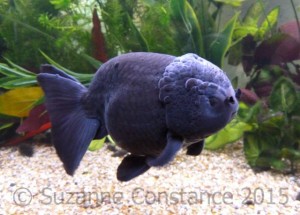
What should you feed your goldfish?
Variety is the spice of life, and your goldfish will certainly thank you for a varied diet. As mentioned above, singletail goldfish can generally eat a wider variety than fancy goldfish, so this section will focus on fancies. Singletails can have all the same food suggestions with the addition of high quality floating pellets and flake if desired.
Feeding fancy goldfish
Generally speaking, flake food should be avoided and a good quality sinking pellet offered instead. Sinking food is preferable for fancy goldfish as it discourages them from eating from the top of the water and helps prevent them taking in air along with their food.
Dry food should ideally be soaked for a minute or two before feeding (not too long otherwise nutrients may leach out into the water). Dry food absorbs water and if the fish stuffs in too much dried food at once (as it will, given the chance, it’s a goldfish!), which then absorbs water and swells up, it might find itself with a nasty case of indigestion and potentially buoyancy problems.
- For sinking pellets take a look at the Tetra, Hikari and Dainichi ranges as these are all popular with fancy goldfish keepers. Soak in a cup of tank water for a minute or so
- Defrosted frozen foods such as bloodworm, brineshrimp and daphnia are also suitable – defrost some in a cup of water and rinse through a tea strainer (best to get a fish-only tea strainer, no one likes bloodworm flavoured tea!)
- Green veg such as blanched broccoli florets, spinach (easiest way to do this is to microwave it for a few seconds until it goes a bit limp), blanched courgette and shelled, defrosted frozen peas. Spinach can be offered in a veg clip stuck to the inside of the glass, broccoli and courgette can have a teaspoon or lead planting weight stuck in it to hold it down, peas just need chopping and they’ll sink by themselves
- Algae wafers – broken up and well soaked these are a nice alternative to pellets sometimes
- Gel food – there are various recipes online but if you don’t fancy making your own you can buy powder to mix with hot water which then sets into a gel, Repashy Soilent Green is suitable (and yes, it is meant to smell like that!)
- Live plants – goldfish do enjoy a nibble on live plants and a supply of elodea is a good idea. This is cheap, grows quickly and will supplement their diet with a good amount of fibre
Have a browse around the tropical fish food too, look at the breakdown of protein etc. on the goldfish food tubs and see what comes close in the tropical foods. Goldfish specific food should be the staple, but a variety on the side works well. Mine are partial to bottom feeder food such as earthworm pellets as an occasional treat, and they also like Maidenhead Aquatics own brand sterlet and sturgeon food!
How much and how often should you feed your goldfish?
Goldfish do need to eat quite a lot, they are big fish after all, but it’s better for them to have a feed at morning and at night rather than one big blowout a day. I tend to give mine their dried food in the morning, then veg and/or defrosted frozen food in the evening. Spreading the food out around the tank will encourage them to rootle about for it and stop them inhaling the whole lot at once! Young fish do well with smaller, frequent feeds while adult fish are content with twice daily feeds. Keeping some live plants in the tank at all times will ensure they can snack when they want to.
How much to feed them is a bit of a balancing act. Underfeeding can cause as many problems as overfeeding. I’ve seen a few suggestions that you should feed the same amount of food as the size of your fishes’ eye. This is rubbish. A goldfish needs rather more than that! As much as they can eat in a couple of minutes is often recommended and this isn’t an unreasonable guide, but don’t underestimate how much they can put away in two minutes! Try a few different portion sizes and don’t be afraid of giving them a reasonable amount, a couple of pellets really isn’t going to cut it, you do need a really good pinch per fish to start with.
As a rough guide, for my adult fish (and these are full sized adults about 30cm long) I give them about a teaspoon of pellets, or two or three algae wafers, or a cube of frozen food, or about four peas per fish per feed. I have a mix of sizes and ages but I find that giving an average portion for each fish allows the larger ones to get a little more and the smaller ones a little less, it sort of balances out between them. They also have a permanent supply of live plants, and I often give them additional feeds here and there.
The following chart shows a rough idea of the size a healthy goldfish should be at various ages, although we think the author may actually have been a little conservative on the adult sizes and would advise adding at least another 2 inches (5cm) to both. You can download it from fishkeeping.co.uk.
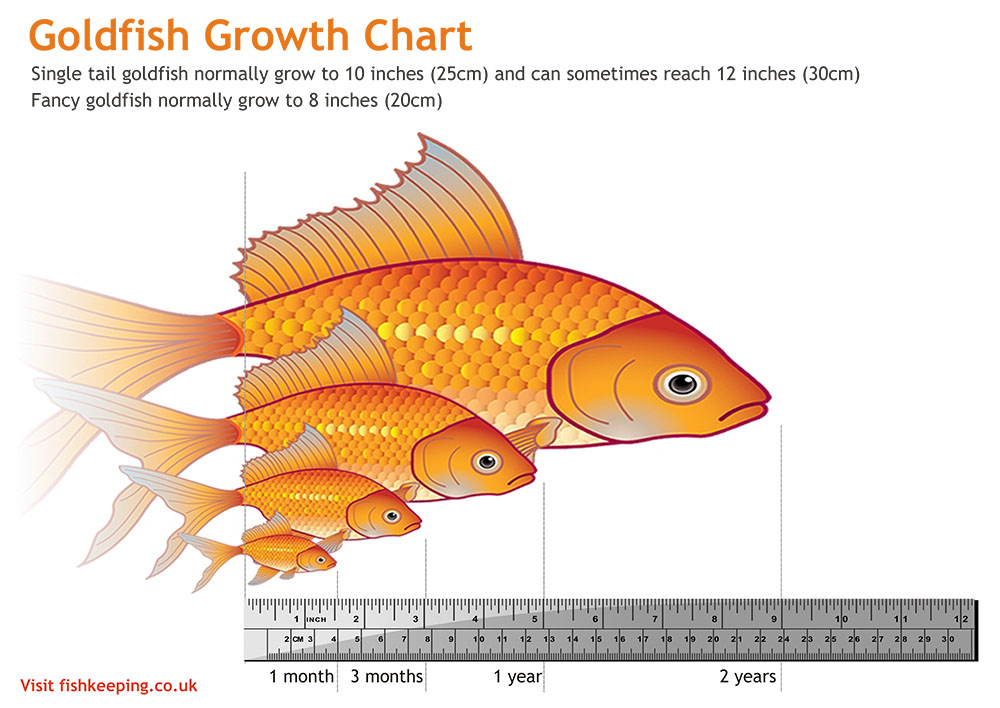
Be warned that goldfish are terrible beggars and put the average Labrador to shame. They are also intelligent and will soon understand that jiggling about excitedly at the front of the tank is likely to result in food. Mine have even managed to con my other half into feeding them a second time once I’ve gone to work in the morning! Sometimes you will need to harden your heart and not give in to those puppy dog eyes, they’ll soon get the message and go and do something else, like eat the plants!
Keep an eye on how much your fish is pooing (yes, fishkeeping’s all about the poo!). Translucent looking poos, like empty sausage cases, can indicate the fish isn’t getting enough. If it’s trailing a mile of poo behind it then it’s likely you need to cut down a little. If the fish is very sluggish and you’ve been feeding a lot try cutting down a little, you don’t want a porker on your hands, fish can get fat! If the fish looks skinny, especially around the belly and rear end, it should probably be eating more. Goldfish should be well rounded, chunky monkeys, a skinny goldfish is an underfed goldfish.
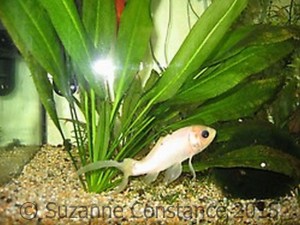
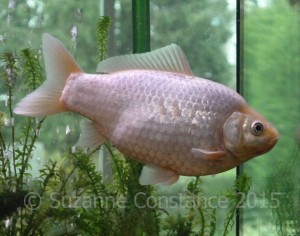
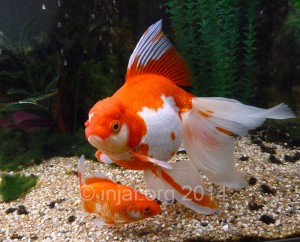
Hopefully the above has helped you understand a little more about your goldfish, and how, what and how much it likes to eat. Don’t be afraid to experiment with different types of vegetables, and remember to mix up the variety, after all, if we ate cheese sandwiches day in day out we’d soon get bored!
Further reading
What size tank for goldfish?
Do fish grow to the size of their tank?
Fancy goldfish swimbladder/buoyancy problems
Author: Suzanne Constance
Photos: Suzanne Constance




